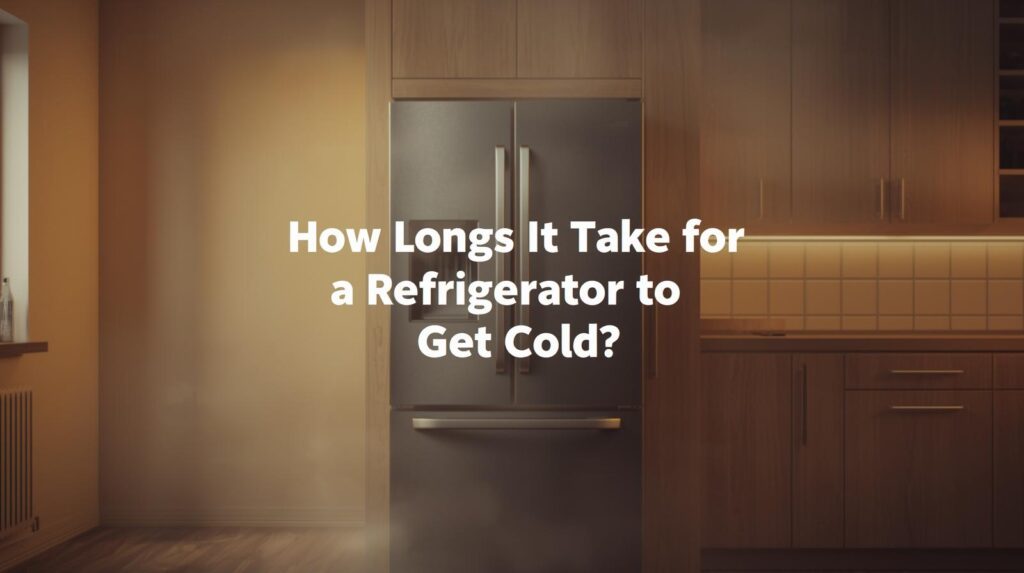How Long Does It Take for a Refrigerator to Get Cold? Cooling Time Explained
You’ve just unboxed a shiny new refrigerator, or perhaps you’ve finally gotten around to cleaning your old one from top to bottom. You plug it in, listen for the satisfying hum, and open the door a few minutes later, expecting a blast of cool air. Instead, you’re met with… nothing. The lingering room temperature air is a stark reminder that patience is a virtue. The immediate question that pops into your head is the very one we’re here to answer: How Long Does It Take to Get a Refrigerator Cold?
The short answer is about 24 hours for a refrigerator to reach its optimal, food-safe temperature of 37°F (3°C). But that’s just the beginning of the story. The real answer is a fascinating mix of physics, engineering, and a few variables you can actually control.
In this guide, we’ll dive deep into the science of cooling, explore what truly affects the timeline, and give you actionable tips to safely speed up the process. Let’s demystify exactly how How Long Does It Take to Get a Refrigerator Cold and why.
The Standard Cooling Timeline: What to Expect
While 24 hours is the golden rule recommended by manufacturers like Whirlpool and GE, the journey to “cold” happens in stages. Understanding these stages can help manage your expectations.
- First 2-4 Hours: You’ll start to feel a noticeable difference. The interior will no longer feel room temperature but will be merely “cool.” This is when the compressor is working hardest to rapidly bring down the initial heat.
- 4-8 Hours In: The refrigerator compartment should feel genuinely cold. You might be tempted to start loading it with groceries, but resist the urge! The temperature is still uneven and hasn’t stabilized.
- 8-24 Hours: This is the stabilization period. The refrigerator slowly and consistently works its way down to the recommended 37°F (3°C). The freezer, which requires a much lower temperature (0°F / -18°C), will take the full 24 hours to be fully ready.
So, when you ask, “How Long Does It Take to Get a Refrigerator Cold,” remember that “cold enough for a soda” and “cold enough to safely store raw chicken” are very different milestones.
Factors That Dictate Your Fridge’s Cooling Speed

Why is there a range instead of a precise number? Your fridge’s cooling time isn’t set in stone; it’s influenced by several key factors. Understanding these is the key to a more efficient cooling process.
1. Type and Size of the Refrigerator
The design of your fridge plays a massive role. A compact mini-fridge has a much smaller cooling system than a massive French door model. Here’s a quick comparison:
| Refrigerator Type | Estimated Cooling Time (to optimal temp) | Key Reason |
| Mini-Fridge / Bar Fridge | 4 – 8 hours | Smaller space and less powerful compressor. |
| Top/Bottom Freezer (Standard) | 12 – 24 hours | Common, efficient design with a direct cooling path. |
| Side-by-Side | 18 – 24 hours | Wider space for the cooling system to manage. |
| French Door | 20 – 24+ hours | Large, open space that takes longer to cool evenly. |
2. Starting Temperature and Ambient Conditions
This is a critical but often overlooked factor. Did you just move the fridge from a hot garage into your 70°F (21°C) kitchen? Or is it a sweltering 90°F (32°C) day? The greater the difference between the appliance’s internal temperature and your kitchen’s ambient temperature, the harder the compressor has to work and the longer it will take.
This is also true for the fridge itself. If it was shipped in a cold truck or you’ve let it acclimate to room temperature after moving it, the starting point is different. The initial cooldown is always the most energy-intensive phase and directly affects how long does it take for a refrigerator to get cold.
3. The “Empty Fridge” vs. “Pre-Loaded” Debate
It seems logical: filling a warm fridge with room-temperature food would make it work harder, right? Surprisingly, the opposite is often true. A fully empty refrigerator is actually less efficient at cooling.
The mass of items inside acts as a “thermal load.” Once cooled, these items help maintain the low temperature, reducing the compressor’s cycling frequency. An empty fridge has only air to cool, which changes temperature rapidly every time you open the door. This is why some experts suggest placing jugs of water in a new fridge to help it stabilize faster. However, you should never add a large amount of warm or hot food, as this will overwhelm the system. If you’re wondering How Long Does It Take to Get a Refrigerator Cold, this balance of thermal load plays a big role.
4. Initial Setup and Ventilation
Your fridge doesn’t just cool its interior—it actually works by moving heat from the inside to the outside. That heat needs somewhere to go. If the refrigerator is crammed into a tight space without proper clearance at the back and sides, the heat gets trapped. This forces the compressor to overwork, slows down efficiency, and significantly increases the time it takes to reach a stable temperature.
To avoid extending the answer to How Long Does It Take to Get a Refrigerator Cold, always follow the manufacturer’s guidelines for clearance space. Adequate airflow around the unit helps it cool faster, run more efficiently, and last longer.
Also Read: How Long Does It Take for Coffee to Kick In
Pro Tips: How to Get Your Refrigerator Cold Faster (and Safely)
You don’t have to just wait passively. Here are four effective ways to reduce the time you spend wondering How Long Does It Take to Get a Refrigerator Cold.
- Start with a Cool, Empty Fridge: The single best thing you can do is let the refrigerator sit unplugged, with its doors open, until it reaches room temperature. This is especially important for a new unit that may have been on its side during delivery, as it allows the compressor oils to settle. Once ready, plug it in and start with an empty interior.
- Set the Thermostat Correctly (and Crank It Initially): As soon as you power it on, set the thermostat to the coldest setting. This tells the compressor to run continuously and kick-starts the cooling process. After 4–6 hours, adjust it back to a normal setting (typically 3 or 4 on a dial, or 37°F / 3°C on a digital display). Don’t leave it on “Max Cool” permanently—this can freeze items in the fridge compartment.
- Maximize Airflow: Make sure the vents inside the fridge are not blocked, since they circulate cold air from the freezer to the refrigerator section. Also, double-check that the external condenser coils (usually located at the back or bottom) have enough clearance for proper ventilation.
- Use Thermal Mass (The Water Bottle Trick): After the fridge has been running for a couple of hours and feels cool, place a few containers or bottles of chilled water (not room temperature) on the shelves. This thermal mass helps stabilize the temperature, reduces fluctuations, and eases the workload on the compressor—an effective hack when figuring out how long does it take to get a refrigerator cold.
What NOT to Do While Waiting for Your Fridge to Cool
In your eagerness to speed things up, it’s easy to make mistakes that can damage your appliance or create unsafe food conditions. If you’ve been wondering how long does it take to get a refrigerator cold, avoiding these missteps will make the process much smoother:
- Don’t Add Warm Food: This is the biggest no-no. Placing a large pot of warm soup or leftover takeout inside will introduce a massive heat source, forcing the compressor to work overtime and drastically increasing cooling time. Always let food cool to room temperature before refrigerating.
- Don’t Constantly Open the Door: Each time you open the fridge, you let cold air escape and warm, humid kitchen air rush in. The refrigerator then has to restart the cooling process for that entire volume of air. Be patient and keep the door shut as much as possible, especially during the first 8 hours.
- Don’t Overload It Immediately: While a little thermal mass can help stabilize temperatures, stuffing the fridge full of groceries right away prevents proper air circulation. This creates warm spots and uneven cooling. Load gradually to help answer the question of how long does it take to get a refrigerator cold with the best results.
The Final Chill: Patience is Key
So, after all this, how long does it take to get a refrigerator cold? The definitive answer is that for a standard, properly installed unit, you should allow a full 24 hours before you trust it with your most perishable items.
Resisting the temptation to rush the process is the safest bet for your food and your appliance’s longevity. The compressor is the heart of your fridge, and a smooth, gradual cooldown is much healthier for it than a frantic, stressed-out one.
By understanding the factors at play and using the tips above, you can optimize the process and confidently answer the question: How Long Does It Take to Get a Refrigerator Cold? With patience, you’ll ensure your appliance provides efficient, reliable cooling for years to come.
Read More Like This: How to Tell if Contact Lens is Still in Eye
Frequently Asked Questions (FAQs)
What’s the quickest a fridge can get cold?
Cool air may be felt within hours, but most refrigerators need 24 hours to reach a safe 37°F (3°C). Mini-fridges can be ready in 4–8 hours.
Does fridge type affect cooling time?
Yes. Large French door models may take 24+ hours, top-freezers are faster, and compact mini-fridges are quickest.
Can I put food in right away?
No. Let the fridge run empty for 4–8 hours. Avoid warm food, but adding cold drinks or water after a few hours can help stabilize temperature.
What’s the #1 mistake with new fridges?
Constantly opening the door. Each time lets in warm air, slowing cooling. Keep it closed as much as possible in the first 8 hours.
My fridge isn’t cold after 12 hours—is this normal?
Often, yes—especially for larger units. Check the thermostat and ventilation. If it’s still not cold after 24 hours, there may be a problem.

